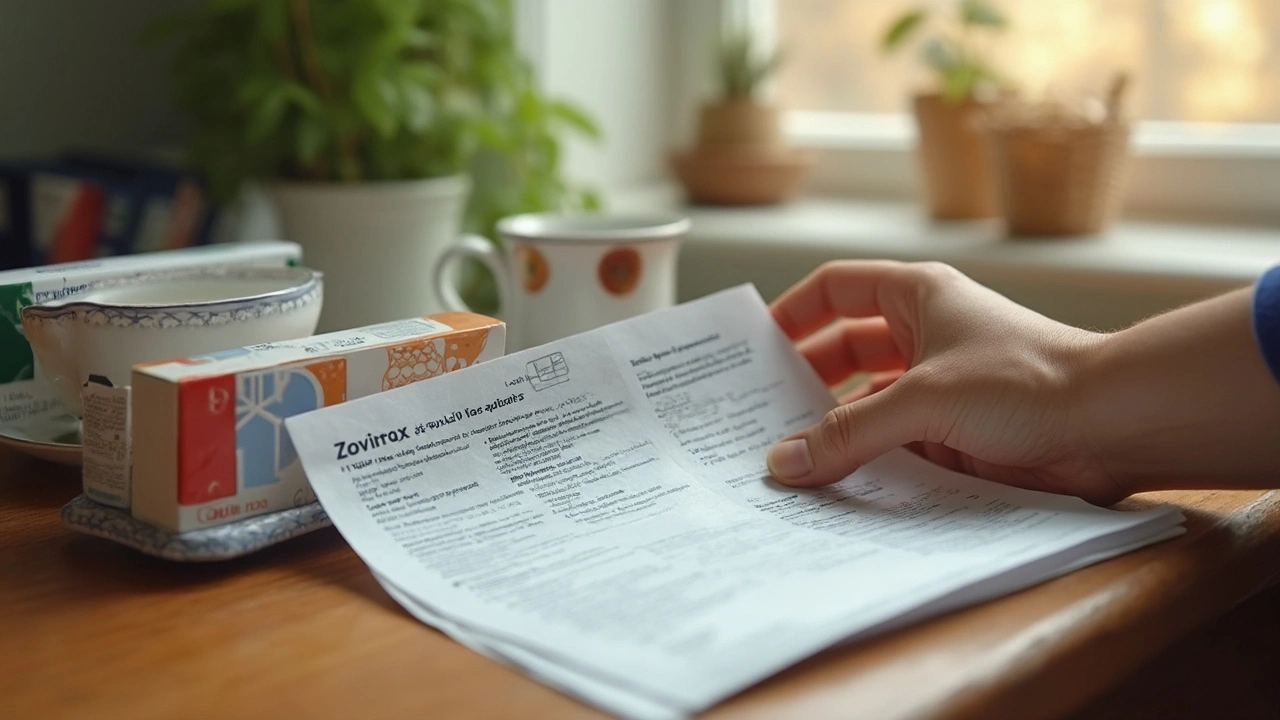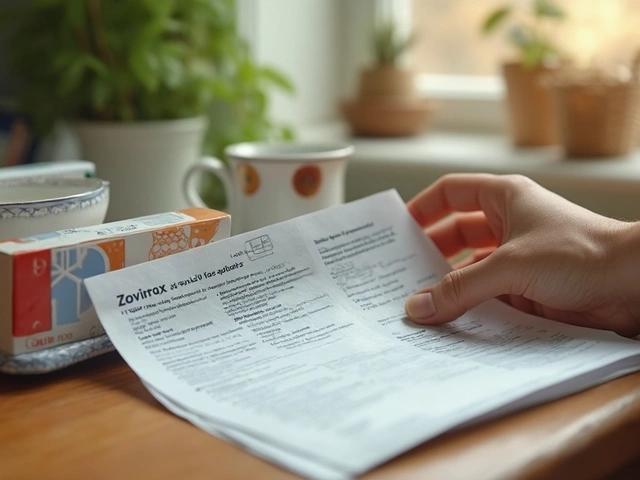If you’ve ever felt the familiar tingle announcing a cold sore, you know the sense of dread that comes next. It’s not just the look—those sores can sting, itch, and hang around for longer than any of us would like. At the center of most medicine cabinets sits that iconic little tube: Zovirax. You’ve seen the name everywhere, but does it actually live up to the hype? Why do doctors recommend it so much—and how do real people use it to get their lives back, fast? It’s time to pare things down to the facts and break through the confusion. Here, we're digging past the marketing fluff so you know exactly what Zovirax is, how it helps, and the details you always wish were in the drugstore leaflet.
What Exactly Is Zovirax and How Does it Work?
First things first, let’s get down to the basics: Zovirax is a brand name for the drug called acyclovir. It’s an antiviral, not an antibiotic, which means it’s used to fight off viruses—not bacteria. The main targets? Herpes simplex virus types 1 and 2 (which cause cold sores and genital herpes), and also sometimes the chickenpox and shingles viruses, but let’s stay focused on cold sores and herpes for now. Instead of actually killing the virus, Zovirax blocks its ability to multiply. That way, your own immune system gets the upper hand and can kick the infection out faster.
It works because the drug sneaks into the viral DNA replication machinery. The herpes virus needs to copy itself to cause that nasty blister. Zovirax puts a stop sign right in the middle of the replication process. That doesn’t mean the sores vanish magically overnight, but it does mean fewer viral particles, a shorter episode, and (if you start early) a much milder time overall. For cold sores, Zovirax comes as a cream you put right on your lips. There’s also a pill form for more severe or frequent outbreaks, and a liquid or even IV version for people with major immune problems. Most people are fine with the classic tube of cream—they just need to know when and how to use it right.
How and When Should You Use Zovirax?
This is the real trick—timing is absolutely everything with cold sores. The best time to use Zovirax is the minute you feel that first tingle, burn, or itch around your lip. Don’t wait for a full blister. As soon as you spot that spot or feel that warning, go for the tube. Clinical studies say that starting treatment at the first sign can shave a couple of days off healing time. It can also lower the risk of the sore getting bigger, spreading, or being as painful as it would if left untreated.
Here’s how most people use it: Wash your hands (no cheating here, you really want things clean), dab a small amount of Zovirax cream on the sore or the itchy/tingly area, and rub it in gently. Wash your hands again—don’t spread the virus to your eyes or elsewhere. Most directions say to do this five times a day, spaced out evenly (usually every 4 hours while you’re awake). That means you’ll probably have to work it into your workday, but it’s worth it. Stick with it until the sore dries up and heals—which could be as little as four days, but sometimes takes longer. The sooner you start, the better. Taking shortcuts or missing applications won’t do you any favors.
- Zovirax cream is only for external use—never put it inside your mouth or eyes.
- Don’t share the tube. Herpes is really contagious, even before a blister forms.
- If you often get cold sores, stash a tube at work, in your bag, or wherever you spend most of your day. The faster you catch symptoms, the better outcome you’ll get.
Side Effects, Safety, and Who Should Avoid It
One of the big reasons Zovirax is popular: it’s well-tolerated by most people. The most common side effects are mild and mostly tied to the skin cream. You might feel a little burning or stinging at the site. Some people have mild redness or dryness of the skin. Overall, these are short-lived and rarely severe enough to make you want to quit. With oral versions (the pill or liquid), some people feel sick to their stomach, get a mild headache, or notice dizziness, but this stuff is usually very manageable.
Let’s talk about who should steer clear. If you’re allergic to acyclovir or any ingredient in Zovirax, obviously don’t use it. Pregnant or nursing? Doctors mostly give the green light for topical use, since barely any gets into your bloodstream, but it’s always smart to double-check. People with weakened immune systems, like folks on chemotherapy or those with HIV, should never self-treat outbreaks—get a doctor’s advice right away. And if you get sores that don’t heal in under two weeks, or they keep coming back monthly, see a professional. That’s not normal, and you might need a bigger workup or a different plan.
When it comes to drug interactions, the cream is easy: hardly anything to worry about, since it’s applied to your skin and barely absorbed. Pills can interact a bit more, especially if you have kidney problems, so just keep your doctor in the loop.

Tips to Get the Most Out of Zovirax
Think of Zovirax like an umbrella in a sudden rainstorm: it works best if you already have it handy, and you don’t stop halfway through the downpour. Keep your prescription up to date (yes, even if you’re not expecting an outbreak), and note when your tubes or packages expire. The active ingredient loses strength over time, so don’t count on that ancient tube in your gym bag if you get caught out.
If you want an edge against repeat outbreaks, put together a quick “cold sore kit.” Alongside Zovirax, you might want antiseptic wipes, lip balm to avoid dryness, and maybe a disposable applicator for public places. Avoid touching or picking at the sore, since that spreads the virus and just makes healing harder. Don’t slather too much cream either; using more doesn't speed things up and can actually irritate your skin. For best hygiene, use a cotton swab or clean finger, and never double dip.
In terms of daily life hacks: try to avoid sharing drinks, towels, razors, or kissing during an outbreak—herpes is crazy contagious at this stage. If sun or stress seem to trigger your sores, add sunscreen lip balm and find your best stress-busting routine. Plenty of people take daily Zovirax pills if they have really frequent outbreaks. That’s called “suppressive therapy” and can cut recurrences by more than half, according to controlled trials from the last couple years.
Frequently Asked Questions and Myths About Zovirax
People ask a ton of questions, many of them born from old wives’ tales. First off: Zovirax is not a cure. Once you pick up the herpes virus, it hangs out in your nerves for life. The goal here is cutting down attacks and making them shorter when they do pop up. Next: can you use Zovirax on genital herpes? Absolutely—there’s a specific 5% ointment for genital herpes, and pills are often prescribed for more serious outbreaks.
Some worry that using Zovirax too often can stop it working. Good news: so far, resistance is rare, especially in healthy people. The virus can mutate a little, but resistance is mostly a problem for severely immunocompromised patients—think transplant recipients and such. And as for Zovirax “scar prevention”—while it can help sores heal faster and lessen the impact, you can still see mild scarring if you pick or scratch. So hands off!
Here are a few more quick myths, busted:
- “You only need to apply Zovirax once for it to work.” Nope. Stick to the routine, five times a day.
- “Zovirax only helps after blisters break out.” Not true—the earlier, the better.
- “You can catch herpes from using someone else’s Zovirax tube.” Yes, you can, which is why sharing isn’t just gross, it’s risky.
Here’s a peek at real-world outcomes for cold sore treatment with Zovirax, drawn from a review of clinical trial results:
| Treatment | Median Days to Healing | Reduction of Outbreak Severity |
|---|---|---|
| Zovirax (acyclovir) cream | 4.6 days | Significant |
| No treatment | 7.9 days | None |
| Placebo cream | 7.4 days | Minimal |
Zovirax in Today’s World: Cost, Access, and the Future
Back in the 1980s, Zovirax was a real breakthrough. Before that, most people had to ride out their herpes and cold sores, hiding out at home or piling on makeup. These days, the generic version, acyclovir, is widely available and much cheaper. Brand-name Zovirax still pops up, but unless you have a strong loyalty to a particular tube, the generic works just as well. You can get it at most pharmacies, and some places (especially in Europe and Canada) sell it right over the counter for cold sores, no prescription needed.
The landscape keeps changing, too. Newer antivirals like valacyclovir (Valtrex) and famciclovir are sometimes used—especially for people with really stubborn outbreaks. These pills can be more convenient, since you usually take them fewer times per day, but topical Zovirax is still the gold standard when you want direct action, low risk of side effects, and a quick response on the spot. Researchers are always working on even better treatments—maybe a true herpes vaccine is coming down the road—but for now, this decades-old drug is still the backbone for managing outbreaks.
Cost-wise, generics are a game changer. In the U.S., a tube of acyclovir cream can range from $10 to $30, but some discount programs drop it even lower. Insurance usually covers the oral forms, and most doctor offices know how to write the script for what you need. And don’t stress if you misplace your cream—a lot of clinics will offer a sample or a new prescription for regular users.
So if cold sores haunt you, or if you just want to be ready for the next random flare, Zovirax (or plain old acyclovir) is still your best first line of defense. Just use it smart—and you can dodge the drama next time those tingles show up.



Comments
Listen, the moment you feel that tingle you’ve got to act-no excuses, no delays, the virus won’t wait, and neither should you-so grab the tube, wash your hands, apply the cream five times a day, and stop second‑guessing yourself!!!
Wow, starting Zovirax at the first whisper of a sore can really shave days off the healing process-keep that tube in your bag, slap it on as soon as you feel the itch, and you’ll be back to smiling in no time! :)
Have you ever wondered why big pharma pushes a single brand when the generic works just as well? It's not a coincidence; the market thrives on keeping us buying the same tube over and over-stay vigilant, read the fine print, and consider the cheaper acyclovir option.
Fact: The 5% acyclovir cream penetrates the epidermis efficiently, achieving therapeutic concentrations within 30 minutes; applying it more than five times a day does not increase efficacy and can actually cause local irritation.
Hey guys, if you’re gonna deal with a cold sore, just keep the routine simple-wash hands, dab the cream, repeat every four hours, and you’ll see the sore shrink fast. No fancy stuff needed!
Folks, remember to store your Zovirax in a cool dry place; a cracked tube won’t spread the medicine properly-keep it with your other health basics and share the tip with anyone who’s new to the game.
Maintain consistency: apply the cream exactly as directed, five applications per day, and monitor the lesion for improvement; adherence ensures optimal viral suppression.
Life throws us those dreaded lip tingles, but with a splash of Zovirax and a dash of optimism 🌟 you can keep the drama low and the smiles high-stay chill, stay covered, and keep the vibe positive! 😊
Yo, keep a spare tube at work-when that tingle hits you’re ready, no excuses, just smash it on and move on!
Our nation’s health must not be shackled by foreign pharmaceutical monopolies-demand locally produced, affordable antivirals and reject the overpriced imports that bleed our wallets dry while we suffer viral onslaughts!
While many praise Zovirax as a miracle, the data show only a modest reduction in lesion duration; reliance on a single topical agent without addressing triggers is a simplistic approach.
First off, congratulations on taking control of your cold sore situation-recognizing the early tingle is the first victory in a battle that many of us fight repeatedly. The beauty of Zovirax lies in its simplicity; a small dab, applied diligently, can turn a looming outbreak into a brief inconvenience. When you keep a tube handy-in your purse, at your desk, or even in your gym bag-you eliminate the dreaded “I forgot” moment that fuels anxiety. Consistency is key, so set a reminder on your phone to apply the cream every four hours while you’re awake; this routine becomes second nature after a few cycles. Remember, the cream works best when paired with good hygiene-wash your hands before and after each application to prevent spreading the virus to other areas. Don’t be fooled by the myth that more cream equals faster healing; the skin can only absorb so much, and excess may cause irritation. Hydration matters too-keep your lips moisturized with a gentle, non‑medicated balm to avoid cracking, which can make the sore more painful. Eating a balanced diet rich in lysine and low in arginine can subtly support the immune system during an outbreak. Stress management should not be overlooked; a quick meditation or a short walk can lower cortisol levels, which otherwise may prolong viral replication. If you find yourself battling more than two outbreaks a month, consider discussing suppressive oral therapy with your physician-sometimes a daily low‑dose pill can halve recurrence rates. It’s also wise to review any other medications you’re on; certain drugs can interact with acyclovir and affect its efficacy. In case the sore doesn’t improve after five days, seek medical advice; persistent lesions may signal a secondary infection or an underlying condition. Share these tips with friends or family who suffer from cold sores; community knowledge is a powerful tool against stigma. Lastly, celebrate each successful treatment-each healed sore is a reminder that you have the power to manage the virus, not the other way around. Keep your spirit high, your routine steady, and the tingles will never catch you off guard again.
Leverage the pharmacokinetic profile of acyclovir-rapid absorption, targeted epidermal action-and you'll optimize therapeutic outcomes; stay on top of dosing and you’ll keep the viral load under control! :)
Avoid sharing the tube.
Listen-if you’re serious about stopping a cold sore, keep the cream within arm’s reach, apply it at the first sign, and follow the five‑times‑daily schedule without exception!!!
Honestly, the key is timing-hit the spot as soon as you feel that itch and you’ll see the lesion shrink dramatically; otherwise you waste precious days.
It is unacceptable to continue using sub‑optimal treatment regimens when evidence clearly supports a structured topical protocol; practitioners must enforce adherence to avoid prolonged morbidity.
I hear how frustrating those recurring sores can be-knowing you have a reliable tool like Zovirax can bring peace of mind, and I’m glad we can share support here. 🙂